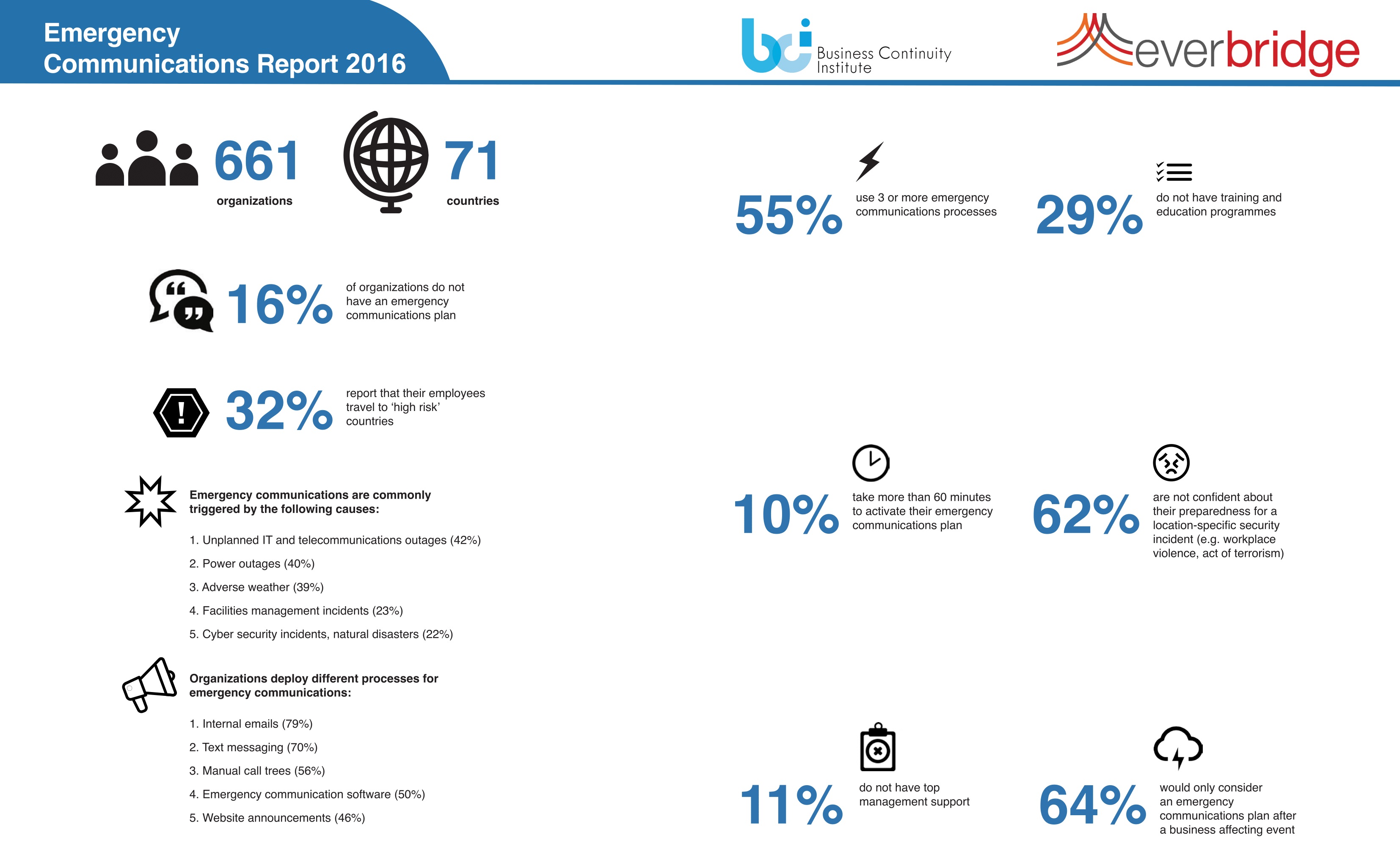Organizations recognising the need for an emergency communications plan
Being able to communicate effectively with staff may have the added advantage of increasing safety
Organizations recognising the need for an emergency communications plan in order to initiate secure and reliable communications to geographically dispersed staff during a crisis
Caversham, UK – 14th December 2016: In our globally connected world, most organizations have staff that travel overseas, making it more important than ever for those organizations to have an effective emergency communications plan in place in order to contact geographically dispersed staff during a crisis. This is especially important given that the latest Emergency Communication Report, published by the Business Continuity Institute, revealed that one out of three organizations (32 percent) report their employees travel to ‘high risk’ countries.
The Emergency Communications Report, supported by Everbridge, a global software company that provides critical communications and enterprise safety applications, did however deliver the encouraging news that most organizations (84 percent) do have some form of plan in place, although it did highlight that for those that don’t, two thirds (64 percent) felt that only a business-affecting event would incentivise them to develop one – most people would consider this too late.
With increasing physical security challenges experienced by organizations due to rising levels of concern surrounding workplace violence and acts of terrorism, as identified in the BCI’s latest Horizon Scan Report, being able to communicate effectively with staff may have the added advantage of increasing safety.
Further findings from the report include
- One third of organizations (32 percent) report that at least 100 employees travel internationally
- The top reasons for triggering emergency communications are: unplanned IT and telecommunications outages (42 percent), power outages (40 percent), adverse weather (39 percent), facilities management incidents (23 percent), cyber security incidents (22 percent), and natural disasters (22 percent)
- The top processes used for emergency communications are: internal emails (79 percent), text messaging (70 percent), manual call trees (56 percent), emergency communication software (50 percent), and website announcements (46 percent)
- More than half of organizations (55 percent) use 3 or more emergency communications processes
- Around 3 out of 10 organizations (29 percent) do not have training and education programmes
- Around 7 out of 10 organizations (69 percent) stated that their emergency communications plan had been activated during the last year, other than during an exercise
- A tenth of organizations (10 percent) take more than 60 minutes to activate their emergency communications plan
- More than 6 out of 10 organizations (62 percent) are not confident about their preparedness for a location-specific security incident (e.g. workplace violence, act of terrorism)
- More than a tenth of organizations (11 percent) do not feel they have top management support when it comes to developing emergency communications plans
Patrick Alcantara DBCI, Senior Research Associate at the BCI and author of the report, commented: “A robust emergency communications capability is a crucial, often life-saving, component of incident response. This becomes more important considering ever changing threats which often impact on the physical safety and well-being of employees and customers. This timely study affirms how organizations strive to improve their emergency communications capability, as well as look at opportunities to ensure reliable messaging and response.”
Imad Mouline, Chief Technology Officer at Everbridge, commented: “This year’s findings indicate that global businesses are increasingly aware that true resiliency is a company-wide initiative that involves taking accountability for the safety of all staff—whether they are located in the office, at home or on the road. While it’s not surprising to see shared interest in emergency communications across business continuity, IT, security, facilities and other disciplines, it’s clear that organizations are still seeking solutions to optimize their response plans for a mobile workforce, and for the growing frequency and complexity of critical events and security incidents.”
Training, education and exercising are good ways to improve emergency communications plans, yet many organizations still have gaps in their training and education programmes related to emergency communications plans which serve as a barrier to embedding this capability. There are also gaps in exercising these plans.
The human element of emergency communications has a significant role in its success. Lack of understanding from recipients is the top reason in failing to deliver effective emergency communications. There is a need for organizations to plan their messages and deliver these in a concise and sustained way in order to raise response levels and direct recipients to perform required actions that may save lives during an incident.
---ENDS---
For more information please contact the Senior Communications Manager at the Business Continuity Institute – Andrew Scott MCIPR CBCI – by emailing andrew.scott@thebci.org or by phoning +44-118-947-8241.
Notes:
- Download a full copy of the report by clicking here.
- Note to the online survey: This report features 661 responses from 71 countries.
About the Business Continuity Institute
Founded in 1994 with the aim of promoting a more resilient world, the Business Continuity Institute (BCI) has established itself as the world’s leading Institute for business continuity and resilience. The BCI has become the membership and certifying organization of choice for business continuity and resilience professionals globally with over 8,000 members in more than 100 countries, working in an estimated 3,000 organizations in the private, public and third sectors.
The vast experience of the Institute’s broad membership and partner network is built into its world class education, continuing professional development and networking activities. Every year, more than 1,500 people choose BCI training, with options ranging from short awareness raising tools to a full academic qualification, available online and in a classroom. The Institute stands for excellence in the resilience profession and its globally recognised Certified grades provide assurance of technical and professional competency. The BCI offers a wide range of resources for professionals seeking to raise their organization’s level of resilience, and its extensive thought leadership and research programme helps drive the industry forward. With approximately 120 Partners worldwide, the BCI Partnership offers organizations the opportunity to work with the BCI in promoting best practice in business continuity and resilience.
The BCI welcomes everyone with an interest in building resilient organizations from newcomers, experienced professionals and organizations. Further information about the BCI is available at www.thebci.org.
About Everbridge
Everbridge, Inc. (NASDAQ: EVBG), is a global software company that provides critical communications and enterprise safety applications that enable customers to automate and accelerate the process of keeping people safe and businesses running during critical events. During public safety threats such as active shooter situations, terrorist attacks or severe weather conditions, as well as critical business events such as IT outages or cyber incidents, over 3,000 global customers rely on the company’s SaaS-based platform to quickly and reliably construct and deliver contextual notifications to millions of people at one time. The company’s platform sent over 1 billion messages in 2015, and offers the ability to reach more than 200 countries and territories with secure delivery to over 100 different communication devices. The company’s critical communications and enterprise safety applications include Mass Notification, Incident Management, IT Alerting™, Safety Connection™, Community Engagement™, Secure Messaging and Internet of Things, and are easy-to-use and deploy, secure, highly scalable and reliable. Everbridge serves 8 of the 10 largest U.S. cities, 8 of the 10 largest U.S.-based investment banks, all four of the largest global accounting firms, 24 of the 25 busiest North American airports and 6 of the 10 largest global automakers. Everbridge is based in Boston and Los Angeles with additional offices in San Francisco, Beijing and London. For more information, visit www.everbridge.com, read the company blog, http://www.everbridge.com/blog, and follow on Twitter and Facebook.
Press release distributed by Pressat on behalf of The Business Continuity Institute, on Wednesday 14 December, 2016. For more information subscribe and follow https://pressat.co.uk/
Emergency Communications Business Continuity Human Resources Facilities Management Risk Management Business & Finance Charities & non-profits Government
You just read:
Organizations recognising the need for an emergency communications plan
News from this source:




